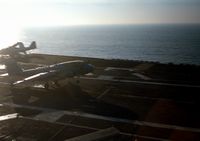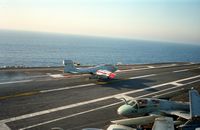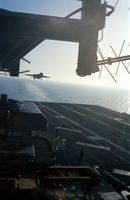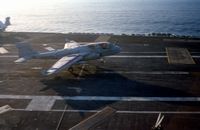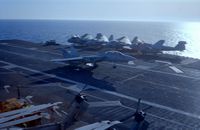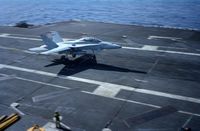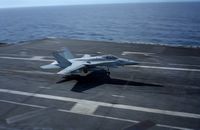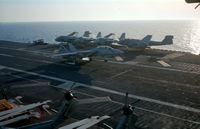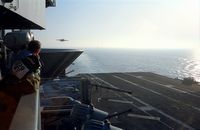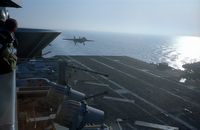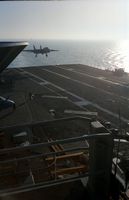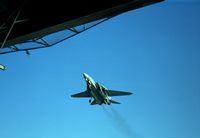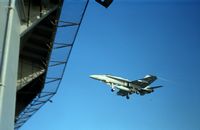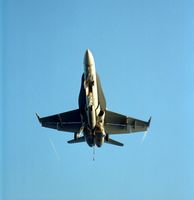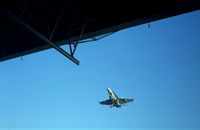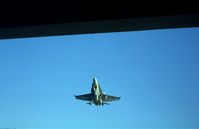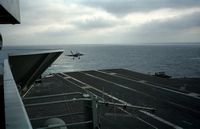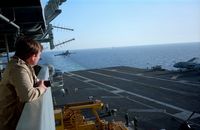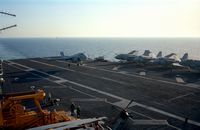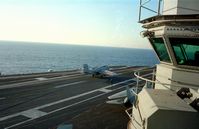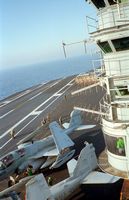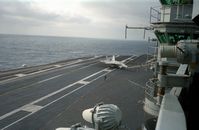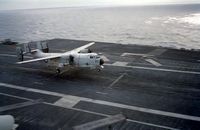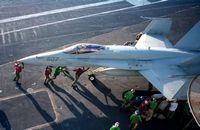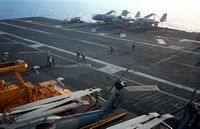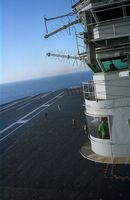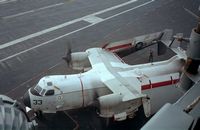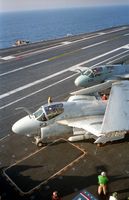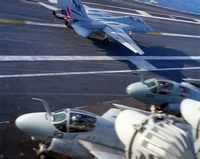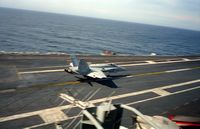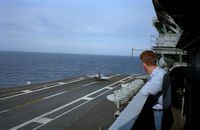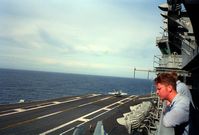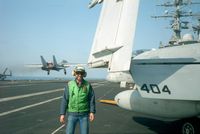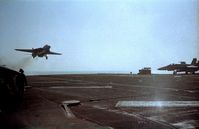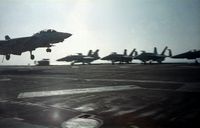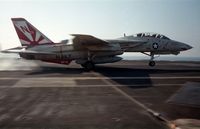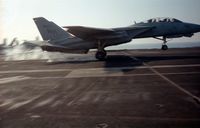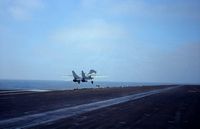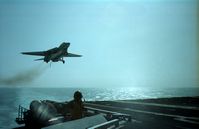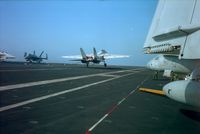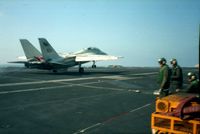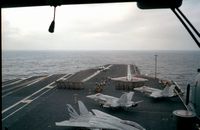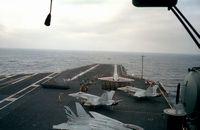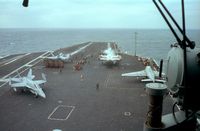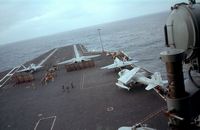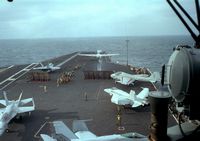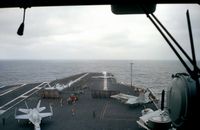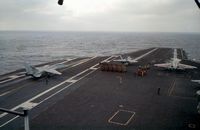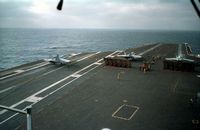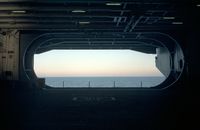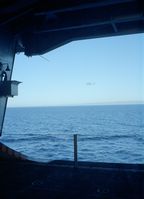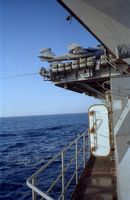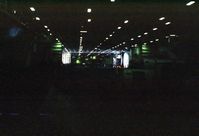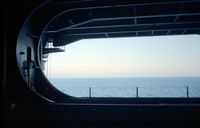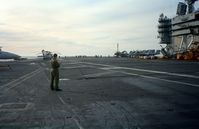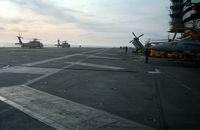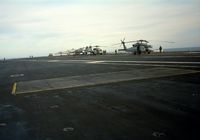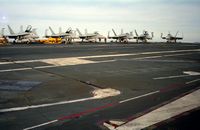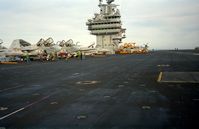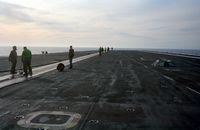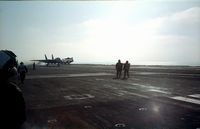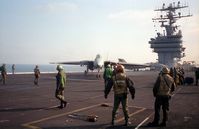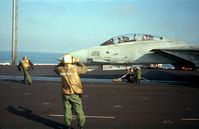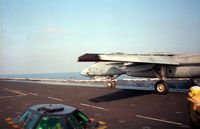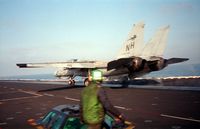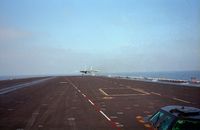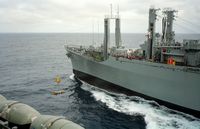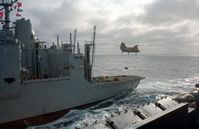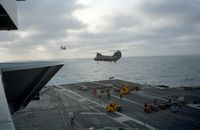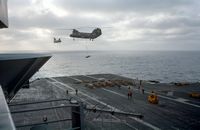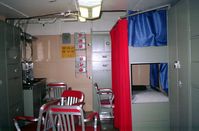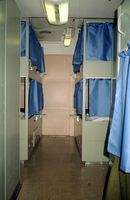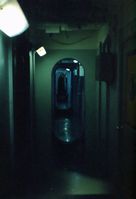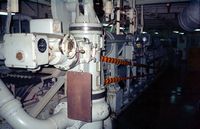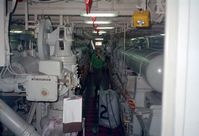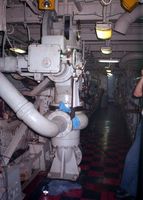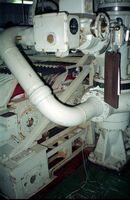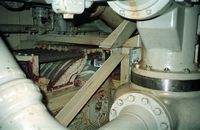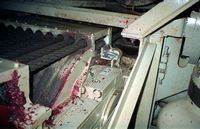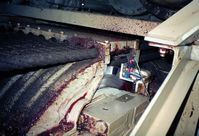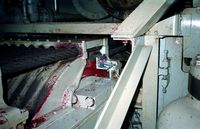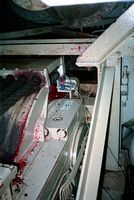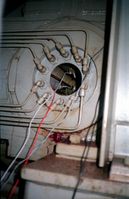CVN 72 - Abe Lincoln
Richard CobbJanuary 1992
These photos were taken while working for NKF Engineering in 1992. I was on the Aircraft Carrier 'Abe Lincoln' (CVN-72) for 6 days while at sea off the California coast. Air operations were conducted around the clock during that time - mainly as qualification/re-qualification for pilots needing to obtain a carrier landing rating, or to keep it current.
I was on the ship to collect vibration data from the 'arresting engines', which stop the aircraft on landing. Think of a 30 foot long hydraulic cylinder (similar to a very large automobile lift in a service station) that is oriented horizontally with multiple pulley sheaves on each end (see images 74-83 below). A large steel cable passes through the sheaves and runs to the carrier deck. The hydraulic cylinder begins at a fully extended position. After an aircraft snags a landing cable, the cable compresses the hydraulic cylinder (making it shorter in length). The hydraulic fluid in the cylinder passes through a controlled orifice which decreases in size as the cylinder compresses. This also has an additional setting for the size of the aircraft, with smaller orifices for larger weights. There are 5 or 6 cables on deck that an aircraft may hook on to. Each of these has two arresting gear engines connected to it.
A problem had arisen on one carrier that had sheave bearings installed that were not properly heat treated, and they had failed prematurely. The question was whether other carriers also had these defective bearings. Considerable time and effort (estimated $50k in 1992 dollars) was required to disassemble and replace the bearings in an engine. 'Condition Monitoring' uses vibration data to determine if there are 'pits' in bearing races, which are an indicator of impending failure. By noting the rotational speed and comparing intermittent vibration spikes to the speed, it is possible to identify pits because they generate a brief vibration pulse every time a ball/roller encounters one. My instrumentation consisted of an optical sensor and a mark on the side of a pulley (image 80 shows a close-up), and accelerometers mounted inside of the pulley shaft (see #83). During my week onboard I collected data from multiple engines. (Later processing showed no significant signs of deterioration, so the bearings were not changed until the next normal overhaul period, thus saving considerable expense).
During this period a couple of crew members I had become acquainted with took me on deck while operations were on-going. I was on deck next to the arresting cables as aircraft landed (pics 33-41), and between the catapults as they took off (62-66). It was one of those lifetime memorable experiences!
Some interesting points:
- Video cameras are mounted on the stern, looking directly up the landing path. Hundreds of monitors are installed all over the ship, and landing approaches were watched (and commented on!) by many. These was no hope that a bad approach would not be noticed!
- The F-14's and F-18's were landing at well over 100 mph, but from the high angles of attack and the wobbly motion at that speed, I had the impression they were just barely hanging in the air
- Even with a good approach, there is no guarantee the hook will snag an arresting cable. Therefore, the moment the wheels touch the deck the pilot goes to full throttle in preparation to take off again. In #30 the cable has just been hooked. #31 shows the final position of the landing. #32 shows an aircraft that missed the cable and is taking off again.
- The cables that the aircraft hook snags are heavier than the ones that pass through the arresting engines. A count is made on the number of catches that each cable makes, and after a fixed number of catches (I think perhaps 100), the cable is immediately replaced, a process that takes only a few minutes. This is shown in image #25.
- Near the end of my stay, ordance (bombs, etc) was transferred off the carrier in preparation for an extended port stay. It was transferred to Mt Hood (#67-70) by cables and Chinook helicopters.
Even though I have served in the military, I was still impressed by the precision of operations onboard an aircraft carrier. It requires 100's of people working simultaneously to conduct air operations. Planes land, are unhooked and moved in quick succession on one part of the deck, while only a few yards away planes are also taking off. Any one person failing to do their job properly could result in major difficulties or disaster. Yet, after a few days it all seems to be 'routine'.
My final thrill for this trip was to be catapulted off the carrier on a COD (Carrier Onboard Delivery) flight. These are propellor aircraft which haul mail, personnel, etc, similar to #23. With no windows there was nothing to see, but it was still quite a thrill. All passengers are strapped in with full harnesses and given instructions for body position during takeoff. The g-force was quite impressive, but it was over in an instant.
